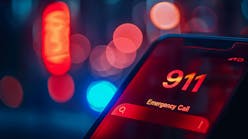One of the great things about thermal imagers is that, for the most part, they are fairly easy to understand. As you look around the dayroom at the firehouse without your thermal imager, you see a couch, a television, a table and a bookshelf. If you looked around the dayroom using only a thermal imager, you would see a couch, a television, a table and a bookshelf. Not too complicated. In the overwhelming majority of thermal imager uses, what you see is what you get (WYSIWYG); however, in certain situations, WYSIWYG is far from the truth and can be misleading and dangerous.
To really understand the nature of thermal reflections, you must understand some basic thermal principles. Thermal radiation is simply a portion of the electromagnetic spectrum. The electromagnetic spectrum describes radiation in terms of energy. Generally speaking, higher energy creates shorter wavelengths and improves penetration. Lower energy produces much larger wavelengths and improves distance. Think of this in terms of AM and FM radio. Watt-for-watt, AM radio gives a broadcaster much more distance than FM; however, FM will do a better job of penetrating commercial buildings. The same could be said for VHF radios when compared to 800 MHz radios.
Thermal energy, being low energy in nature, is easily reflected by many different types of surfaces. A mirror, the side of a fire engine, a dry-erase board, ceramic tile, stainless steel appliances, glass; these all have the potential to create thermal reflections. Of these, glass seems to cause the most confusion for firefighters. This is likely because glass is a surface that reacts differently to light than thermal. When we look at a window, for instance, with our eyes, we can see straight through it; with a thermal imager, it is the same as looking at a mirror. Your thermal imager cannot see through glass. When thermal energy strikes glass, it is reflected. Image 1 shows the view of a commercial door side-by-side with the exact same view as seen through the thermal imager.
Reflections can lead to confusion, and confusion can lead to mistakes. False impressions can arise when dealing with reflections. These can be as simple as mistaking the location of something seen on the thermal imager or as complicated as attempting to suppress a fire that does not exist. In Image 2, look closely at the tip of the nozzle. You can see the red and yellow colorization, an indication of high heat. The tip of the nozzle is not really that hot; you are seeing the reflection of the training fire immediately to the left of the image clearly reflected in the tip of the nozzle.
This is a simplified example, but scale it up a bit and it could be extremely confusing. Imagine being assigned to suppression and moving quickly through a residential structure fire. You round a corner and all of a sudden you see a large body of fire. You direct the hose stream just above the fire and open the nozzle. After a quick attack pattern, you close the nozzle and realize that the body of fire did not change despite being directly attacked by your 200-gpm onslaught. As you crawl closer, you realize that you just applied 200 gpm to the patio door and the fire is elsewhere in the room.
Imagine searching a home in thick smoke. After making your way down a long hallway, you enter a room that immediately resembles a hall of mirrors at the carnival. You see reflections off of the floor and walls. You spot several toilets and what appear to be multiple shower doors. Understanding reflections, you realize that this is a bathroom that likely has marble tile across the floor and walls. You realize that you are seeing reflection upon reflection. Rather than search this room with the imager, you opt to continue to search it by hand so as not to get confused by the reflections. Once complete, you can resume the use of the thermal imager in the hallway without confusion.
The good news is that reflections are something that you can train for. You can practice by walking around the firehouse with the thermal imager and identifying various surfaces that can create reflections. When you encounter a surface that you did not realize would be reflective, investigate it and develop a better understanding of what you are seeing. Once you have completed a walk-through, try crawling and doing the same thing.
Reflections can be downright misleading. However, once recognized, their effect can be minimized through training. Train to recognize the potential for reflections and eliminate misinterpretations caused by reflections. The more you find in training, the less you have to find in the heat of battle where the stakes are much higher.
BRAD HARVEY is the Thermal Imaging Product Manager at Bullard. He is a veteran of public safety as a firefighter, police officer and paramedic and is certified through the Law Enforcement Thermographers' Association (LETA) as a thermal imaging instructor. Harvey has worked as a high-angle rescue instructor and is a certified rescue technician and fire instructor. If you have questions about thermal imaging, you may e-mail him at [email protected].





